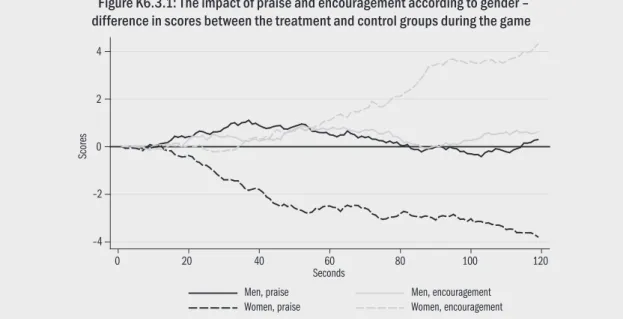–4 –2 0 2 4
Scores
0 20 40 60 80 100 120
Seconds
Men, praise Men, encouragement
Women, praise Women, encouragement
AnnA Lovász & ágnes szAbó-MorvAi
140
K6.3 The effect of motivation and feedback Anna Lovász & Ágnes Szabó-Morvai Gender related differences in school and work
performance may partly be explained by the dif- ferences in non-cognitive characteristics between the genders (for example men tend to have greater self-confidence and be more competitive) and that the conditions and rules of a given environment (such as the labour market) favour men because of the attributes characteristic of them (for ex- ample those with more self-confidence are more successful at wage negotiations and those who like to compete are more likely to be promoted) (Nie derle, 2016).
A recent study (Lovász et al. 2017) explored whether encouragement (‘You can do it’) or praise (‘Well done!’) affect performance differently, de-
pending on gender. In an online game, individ- uals were randomly assigned to a control group (did not get encouragement or praise) or a treat- ment group (got encouragement or praise). Fig- ure K6.3.1 presents the differences in the average scores of the treatment and control groups during the game. Women were affected more strongly by both encouragement (positively) and praise (nega- tively) than men. These effects are strongly related to the lower self-confidence of women: men with low self-confidence were influenced by both treat- ments similarly to women. This suggests that in- dividualised, subjective feedback may increase the performance of certain (less confident) groups, es- pecially of women, during certain tasks.
Figure K6.3.1: The impact of praise and encouragement according to gender – difference in scores between the treatment and control groups during the game
References
Lovász, A.–Cukrowska-Torzewska, E–Rigó, M.–
Szabó-Morvai, Á. (2017): Gender Differences in the Effect of Subjective Feedback. Budapest Working Pa- pers on the Labour Market, BWP, No. 1705.
Niederle, M. (2016): Gender. In: Roth, A. E.–Kagel, J. H. (eds.): Handbook of Experimental Economics.
Volume 2, pp. 481–553. Princeton University Press, Princeton.
